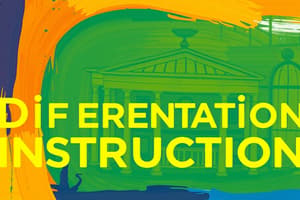Podcast
Questions and Answers
What is the primary goal of differentiated instruction?
What is the primary goal of differentiated instruction?
The primary goal of differentiated instruction is to increase student engagement and motivation, improve academic achievement, and enhance teacher-student relationships.
What are some strategies used in differentiated instruction?
What are some strategies used in differentiated instruction?
Strategies used in differentiated instruction include tiered assignments, learning centers, tiered assessments, and flexible grouping.
What is the purpose of accommodations for diverse learners?
What is the purpose of accommodations for diverse learners?
The purpose of accommodations for diverse learners is to modify instructional materials and methods to ensure access and equity for students with disabilities, language differences, and cultural diversity.
What are some types of accommodations for diverse learners?
What are some types of accommodations for diverse learners?
What is an example of a presentational accommodation?
What is an example of a presentational accommodation?
How can multimedia resources support English language learners?
How can multimedia resources support English language learners?
Flashcards are hidden until you start studying
Study Notes
Adaptation of Instructional Materials
Differentiated Instruction
- Definition: Tailoring instruction to meet the diverse needs of students, including learning styles, abilities, and interests.
- Goals:
- Increase student engagement and motivation
- Improve academic achievement
- Enhance teacher-student relationships
- Strategies:
- Tiered assignments: Providing multiple levels of complexity and challenge
- Learning centers: Stations with diverse activities and materials
- Tiered assessments: Multiple formats to accommodate different learning styles
- Flexible grouping: Dynamic grouping based on student needs and goals
Accommodations for Diverse Learners
- Definition: Modifying instructional materials and methods to ensure access and equity for students with disabilities, language differences, and cultural diversity.
- Types of Accommodations:
- Presentational: Adapting how information is presented (e.g., visual, auditory, tactile)
- Response: Adapting how students respond to information (e.g., written, oral, typed)
- Setting: Adapting the learning environment (e.g., noise reduction, adaptive seating)
- Timing: Adapting the pace and scheduling of instruction
- Examples of Accommodations:
- Providing Braille or large-print materials for students with visual impairments
- Offering bilingual or multilingual instructional materials
- Using multimedia resources to support English language learners
- Providing graphic organizers and visual aids for students with learning disabilities
Adaptation of Instructional Materials
Differentiated Instruction
- Definition: A student-centered approach that tailors instruction to meet the diverse needs of students, including learning styles, abilities, and interests.
- Goals:
- Increase student engagement and motivation
- Improve academic achievement
- Enhance teacher-student relationships
- Strategies to achieve differentiated instruction:
- Tiered assignments: Providing multiple levels of complexity and challenge to cater to different learning abilities
- Learning centers: Stations with diverse activities and materials to accommodate different learning styles
- Tiered assessments: Multiple formats to accommodate different learning styles and abilities
- Flexible grouping: Dynamic grouping based on student needs and goals to promote collaborative learning
Accommodations for Diverse Learners
- Definition: Modifying instructional materials and methods to ensure access and equity for students with disabilities, language differences, and cultural diversity.
- Types of Accommodations:
- Presentational: Adapting how information is presented to cater to different learning styles (e.g., visual, auditory, tactile)
- Response: Adapting how students respond to information to accommodate different abilities (e.g., written, oral, typed)
- Setting: Adapting the learning environment to promote inclusivity (e.g., noise reduction, adaptive seating)
- Timing: Adapting the pace and scheduling of instruction to meet individual needs
- Examples of Accommodations:
- Providing Braille or large-print materials for students with visual impairments
- Offering bilingual or multilingual instructional materials to support language diversity
- Using multimedia resources to support English language learners
- Providing graphic organizers and visual aids for students with learning disabilities
Studying That Suits You
Use AI to generate personalized quizzes and flashcards to suit your learning preferences.




